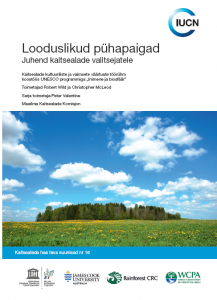
एस्टोनिया मध्ये, सुमारे 2500 पारंपारिक पवित्र नैसर्गिक साइट, जमीन मोठ्या भागात पांघरूण आध्यात्मिक लक्षणीय असू म्हणून ओळखले जातात, सांस्कृतिक आणि नैसर्गिक वारसा मूल्ये. पुढील संशोधन आणि दस्तऐवज तितकी नेटवर्क प्रकट अपेक्षित आहे 7000 फक्त देशातील पवित्र नैसर्गिक साइट.
 With the support of Estonian Ministry of the Environment the NGO “Taara आणि नेटिव्ह धर्म एस्टोनियन हाऊस (Taarausuliste ja Maausuliste Maavalla Koda)” translated the IUCN UNESCO “पवित्र नैसर्गिक साइट्स, संरक्षित क्षेत्र व्यवस्थापक मार्गदर्शक तत्वे” into Estonian. Maavalla Koda in cooperation with state environmental institutions is now able to use the Guidelines to improve recognition, protection and promotion of sacred natural sites. The Guidelines will contribute to the implementation of the ministry of culture’s national conservation plan for sacred natural sites and will be supported by training of state officials and custodians of sacred natural sites. To this end a support group was formed by 17 members of Estonian parliament in the spring of 2011.
With the support of Estonian Ministry of the Environment the NGO “Taara आणि नेटिव्ह धर्म एस्टोनियन हाऊस (Taarausuliste ja Maausuliste Maavalla Koda)” translated the IUCN UNESCO “पवित्र नैसर्गिक साइट्स, संरक्षित क्षेत्र व्यवस्थापक मार्गदर्शक तत्वे” into Estonian. Maavalla Koda in cooperation with state environmental institutions is now able to use the Guidelines to improve recognition, protection and promotion of sacred natural sites. The Guidelines will contribute to the implementation of the ministry of culture’s national conservation plan for sacred natural sites and will be supported by training of state officials and custodians of sacred natural sites. To this end a support group was formed by 17 members of Estonian parliament in the spring of 2011.
The Guidelines are number 16 in the World Commission on Protected Areas’ Best Practice Series (view here) and have been developed by the Specialist group on Cultural and Spiritual Values of protected Areas. “The Guidelines are in high demand. Since their launch at the IUCN World Conservation Congress in 2008 they have been translated from English into Russian, Spanish and Estonian whilst French and Japanese versions are in the making” says Mr. रॉबर्ट जंगली, co-author of the Guidelines and chair to CSVPA. With support of the WCPA and the Christensen Fund the Guidelines are currently being translated, tested, reviewed and expanded with new case studies by the Sacred Natural Sites Initiative.
The Estonian case of sacred natural sites conservation is one of approximately 35 cases that are part of the Delos पुढाकार, an initiative working to improve the conservation of scared natural sites in technologically developed countries. “During the third workshop of the Delos Initiative in Inari in 2010 I learned about the efforts of IUCN’s Specialist Group on Cultural and spiritual Values to protect and conserve sacred natural sites world wide. I realised that the IUCN UNESCO Guidelines would be a very effective tool for conserving sacred natural sites in Estonia” says Mr. Atho Kaasik the elder of Maavalla Koda.
Although the total area of Estonia is no more than 47.000 km2, several different linguistic and cultural areas are found within its territory, and hence there are also regional variations in the types and names of sacred natural sites. उदाहरणार्थ, rocks and trees used for healing are common in the western part of the country. Communal sites bearing the name of या (sacred grove) are spread in the northern and western parts of the country. The tradition of cross-trees associated with funeral customs is preserved only in South-East Estonia.
From a wider perspective, Estonian sacred natural sites form part of Fenno-Ugric sacred site traditions. For historical reasons, Estonian traditional religion maausk has largely evolved as familial, personal and confidential. Sacred natural Sites are used for praying, healing, asking for blessing to one’s marriage, giving a name to one’s child, counselling, making offerings and carrying out various rituals, especially on holy days of the folk calendar. आज, sacred natural sites are under threat of extinction mainly because of lack of legal regulation and awareness about sacred natural sites.






